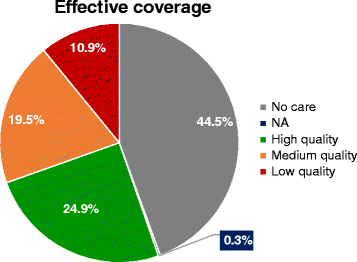Effective coverage of essential inpatient care for small and sick newborns in a high mortality urban setting: a cross-sectional study in Nairobi City County, Kenya
- PMID: 29783977
- PMCID: PMC5963150
- DOI: 10.1186/s12916-018-1056-0
Effective coverage of essential inpatient care for small and sick newborns in a high mortality urban setting: a cross-sectional study in Nairobi City County, Kenya
Abstract
Background: Effective coverage requires that those in need can access skilled care supported by adequate resources. There are, however, few studies of effective coverage of facility-based neonatal care in low-income settings, despite the recognition that improving newborn survival is a global priority.
Methods: We used a detailed retrospective review of medical records for neonatal admissions to public, private not-for-profit (mission) and private-for-profit (private) sector facilities providing 24×7 inpatient neonatal care in Nairobi City County to estimate the proportion of small and sick newborns receiving nationally recommended care across six process domains. We used our findings to explore the relationship between facility measures of structure and process and estimate effective coverage.
Results: Of 33 eligible facilities, 28 (four public, six mission and 18 private), providing an estimated 98.7% of inpatient neonatal care in the county, agreed to partake. Data from 1184 admission episodes were collected. Overall performance was lowest (weighted mean score 0.35 [95% confidence interval or CI: 0.22-0.48] out of 1) for correct prescription of fluid and feed volumes and best (0.86 [95% CI: 0.80-0.93]) for documentation of demographic characteristics. Doses of gentamicin, when prescribed, were at least 20% higher than recommended in 11.7% cases. Larger (often public) facilities tended to have higher process and structural quality scores compared with smaller, predominantly private, facilities. We estimate effective coverage to be 25% (estimate range: 21-31%). These newborns received high-quality inpatient care, while almost half (44.5%) of newborns needed care but did not receive it and a further 30.4% of newborns received an inadequate service.
Conclusions: Failure to receive services and gaps in quality of care both contribute to a shortfall in effective coverage in Nairobi City County. Three-quarters of small and sick newborns do not have access to high-quality facility-based care. Substantial improvements in effective coverage will be required to tackle high neonatal mortality in this urban setting with high levels of poverty.
Keywords: Africa; Effective coverage; Health services research; Inpatient newborn services; Kenya; Neonatal care; Newborn health; Paediatrics; Quality of care.
Conflict of interest statement
Ethics approval and consent to participate
Ethical approval has been granted by KEMRI Scientific and Ethics Review Unit (SSC protocol 2999). The study was conducted in collaboration with the Nairobi City County government. Written informed consent to conduct this study was obtained from the medical supervisor or equivalent authority in charge of each facility.
Competing interests
The authors declare that they have no competing interests.
Publisher’s Note
Springer Nature remains neutral with regard to jurisdictional claims in published maps and institutional affiliations.
Figures



References
-
- United Nations. Sustainable Development Goals: Goal 3. https://sustainabledevelopment.un.org/sdg3. (Accessed 26 May 2017).
-
- Countdown to 2015. A Decade of Tracking Progress for Maternal, Newborn and Child Survival: The 2015 Report. Geneva: UNICEF and World Health Organisation. 2015.
Publication types
MeSH terms
Grants and funding
LinkOut - more resources
Full Text Sources
Other Literature Sources

